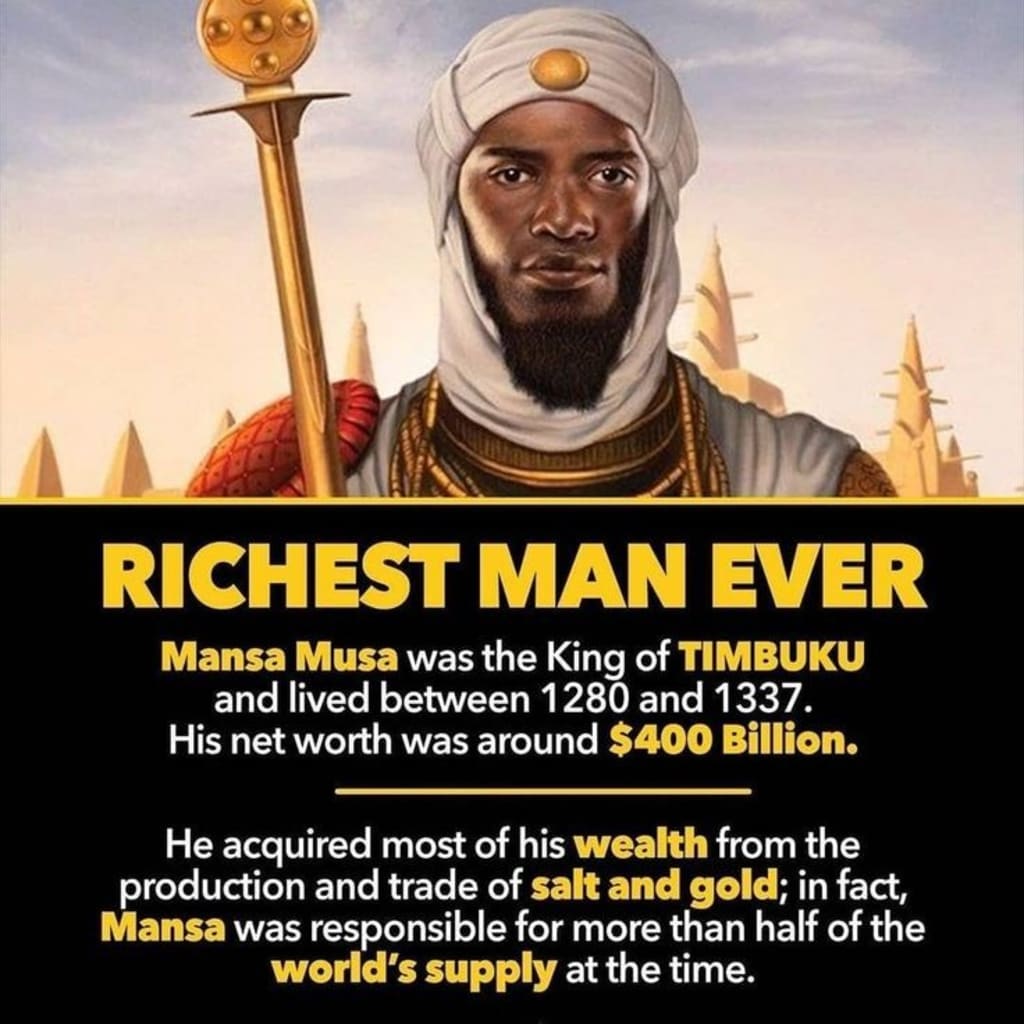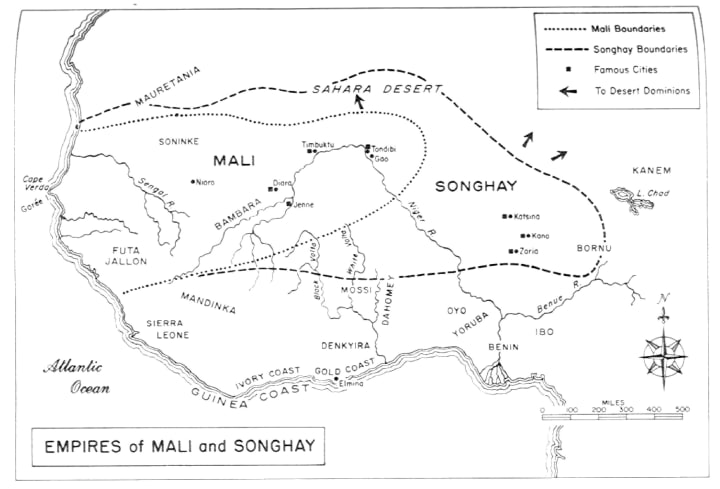Africa’s Most Flamboyant Emperor: “King of Kings” Mansa Musa of the Mali Empire
“You’ve heard about the extraordinary wealth of Bill Gates, J.P. Morgan, and the sultan of Brunei, but have you heard of Mansa Musa, one of the richest men who ever lived?” - Cynthia Crossen

The Mali Empire of West Africa was one of Africa’s greatest states during medieval times. Mali’s history goes back to the 7th century, but it owes its fame to two great men, Sundiata Keita and Gonga (Kankan) Musa. “Mansa Musa,” the best-known ruler of the ancient (Western) Sudan, came to power in 1307 and put together one of the greatest countries of the medieval world.
The gentle Mandinka people were responsible for their country being comparable in size to all Western Europe combined during the 14th century.
The Magna Charter, also known as the charter of Kurukanfuga governed the Mali civilization and it advocated social peace in diversity, the protection of human beings against any kind of violence, education, the integrity of the homeland, food security, the abolition of enslavement and human exploitation, or freedom of speech, etc.
Ibn Battuta, the famous Muslim travel writer of the Middle Ages, favorably described the Malians:
“The [N]egroes … are seldom unjust, and have a greater abhorrence of injustice than any other people. Their sultan shows no mercy to anyone who is guilty of the least act of it. There is complete security in their country. Neither traveller nor inhabitant in it has anything to fear from robbers or men of violence.”
By respecting this charter (Kurukanfuga), the successors of Sundiata Keita inherited a stable and well-structured state which allowed the empire to reach its peak under the reign of Mansa Musa in 1312.

Kankan Musa became Mansa (i.e., Emperor) Musa and officially took the throne of Mali in 1312 AD. His total rule was 25 years. As the fame of Mali spread across the Mediterranean Sea to Europe, Mansa Musa’s name became known throughout the world. He extended the boundaries of his empire by diplomacy and war.

“Europe during the middle ages had some knowledge of these movements in the Sudan and Africa. Melle (Mali) and Songhay (Songhai) appear on medieval maps.” – Dr. W.E.B. Du Bois
Mansa Musa’s Hajj was a part of West African history that showed how rich West Africa was and still is. Mansa Musa’s Hajj was the most fabulous on record. For example, it was so great that it astonished and amazed people through the countries that he traveled to, to reach Arabia. In fact, even after 100 years, the descendants of those people continued to talk about Mansa Musa’s famous Hajj. The journey was more than 5,000 miles round trip. One could only imagine the amount of food, water, medicine, and money it would take for such a trip during medieval times.
The Malian emperor went to Arabia in regal splendor with an entourage of 60,000 persons, including 1,200 servants. 500 bondsmen, each of whom carried a staff of pure gold, marched in front of the emperor. Included in Mansa Musa’s entourage were many members of his family, close friends, doctors, teachers, and his local chiefs of the Empire whom he wanted to honor. 280 camels bore 2,400 pounds of gold which this African monarch distributed as alms and gifts. There were assembled about 100 camel-loads of pure gold dust, with each load weighing 300 pounds. Compared to today’s gold prices of $400 to $500 per ounce, the projected amount is approximately $160 million. All along his route, Mansa Musa gave away little bags of gold. He was extremely generous to all of those who performed any type of service.
It was in July 1324, when Mansa Musa entered Egypt, and he was an immediate celebrity and sensation. He gave away so much gold, that the overabundance upset the economy of Egypt for 12 years. Mansa Musa returned from Mecca (Arabia) to Mali with an architect who designed imposing buildings in the famed kingdom of Timbuktu and other parts of his country. To the outside world of the late medieval period, Emperor Mansa Musa was more than an individual, because he was Africa (Alkebu-lan: land of the Spirit People).
“He (Mansa Musa) was the most colorful of the Black kings of the fourteenth century. He still held this position nearly two centuries after his death.” – Dr. John Henrik Clarke
In a recent book, Cynthia Crossen, senior editor of the prestigious financial newspaper Wall Street Journal, wrote: “You’ve heard about the extraordinary wealth of Bill Gates, J.P. Morgan, and the sultan of Brunei, but have you heard of Mansa Musa, one of the richest men who ever lived?” Continuing this theme, Mrs. Crossen comments that “Neither producer nor inventor, Mansa Musa was an early broker, greasing the wheels of intercultural trade. He created wealth by making it possible for others to buy and sell.”
Dr. Basil Davidson suggested that the rulers of Mali were “rumored to have been the wealthiest m[e]n on the face of the earth.”
After the death of Mansa Musa, the empire of Mali declined in importance. Its place was taken by the Songhai Empire. The Songhai (Songhay) people and their massive empire was the same size as all of Europe combined during the 16th century; right before the Transatlantic slave trade reached West Africa's shores. One of Songhai’s greatest emperors was Askia (i.e., Emperor) Mohammed Touré I (Askia the Great). Askia Mohammed came to power in 1493, just one year after Christopher Columbus landed in America.
“The first and perhaps the most important fact is that the general enslavement of Africans, proclaimed to the world as savages, began during the very period and in the very West Africa, the center of which held one of the great universities of the world and other colleges.” – “The Black Revival of Learning,” p. 247

“They (Black people) will be coming back ─center stage─into their own history at last. But to what end? Will it be just for the intellectual satisfaction of knowing our true history? Knowing it, yes─but so what? The answer is nothing─unless from history we learn what our strengths were and, especially, in what particular aspect we were weak and vulnerable. Our history can become at once the foundation and guiding light for united efforts in serious planning what we should be about now.” – Dr. Chancellor Williams
Sources:
Ba, A. Mali Empire 13th-15th Century: Symbol of the Political Force of a United Africa. Editions AB, 1st edition. (July 11, 2021). May 30, 2023. Location: 343, 433, 443.
Battle, R., Robinson, C., Robinson, E. The Journey of the Songhai People. Pan African Federation Organization; 2nd edition. (June 1, 1992). May 30, 2023. p. 15, 94-96, 271.
Bennett, L. Before The Mayflower: A History of The Negro in America, 1619-1962. Ebooks for Students, Ltd. (January 6, 2021). May 30, 2023. p. 29, 52.
Clarke, J. Christopher Columbus and the Afrikan Holocaust: Slavery and the Rise of European Capitalism. Publishers Group. May 7, 2015. May 30, 2023. p. 41.
Du Bois, W. The Negro. A Public Domain Book. (May 17, 2012). May 30, 2023. p. 28.
Santhosh. Richest Man Ever | Hustle Grind. Santhosh. Pinterest. May 30, 2023. https://www.pinterest.com/pin/690739661609600558/
Sertima, I. Golden Age of the Moor. Transaction Publishers; 2nd Printing edition. (January 1, 1990). May 30, 2023. p. 270, 275.
Walker, R. When We Ruled: The Ancient and Mediaeval History of Black Civilizations. Black Classic Press. (May 1, 2011). May 30, 2023. p.114, 372-373, 378, 384-385.
Williams, C. The Destruction of Black Civilization: Great Issues of a Race from 4500 B.C. to 2000 A.D. Third World Press; 3rd Revised ed. edition. (Feb. 1, 1992). May 30, 2023. p. 45, 208-209.
Wikipedia. Mali Empire. May 30, 2023. https://en.wikipedia.org/wiki/Mali_Empire
About the Creator
Darryl C. Richie
Inspirational Speaker, Author and Blogger looking to inspire with my story of being a two-time cancer survivor and hip amputee, and connect the African Diaspora to their African roots via Black Consciousness.
Reader insights
Outstanding
Excellent work. Looking forward to reading more!
Top insight
Compelling and original writing
Creative use of language & vocab






Comments
There are no comments for this story
Be the first to respond and start the conversation.